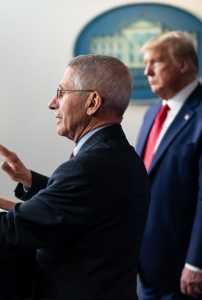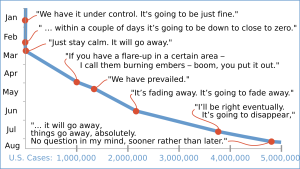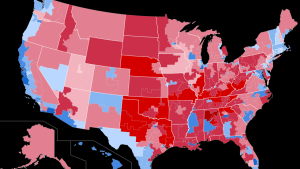13
Claudia Sisk
Introduction

In the most technologically advanced and educated era of human existence, what happens when a scientific disaster is treated as political fodder at the expense of human life? In this chapter, we will dive into how America’s political sphere has politicized COVID-19, how the shortcomings in our pandemic response were exacerbated by the election cycle, and how the college experience is transformed by it. Information related to COVID-19 spread and perception has saturated the public eye and been weaponized in the form of propaganda, election campaigns, and political platforms in response to an extremely polar election year, resulting in a skewed and disunified pandemic response. It has affected every person in America to some capacity, from incorporating face masks into fashion trends to mass layoffs, rising unemployment, and the collegiate world is also facing a particular set of challenges brought on by a disunified front in the face of
the pandemic.
Connection to STS Theory
The dynamics between the pandemic and our perception of it paints a detailed picture of what the relationship between science and society looks like today. Though it may seem archaic to insist that society and science have a strained relationship, as seen with Galileo and the Catholic Church, one can see America’s resistance to unify against the spread of COVID-19 and it’s devolution into a political talking point as an indicator that the virus isn’t being treated as what it is: scientific fact. Given the modern dependency on technology, it seems obvious that nations would accept science due to its typically factual and logical nature. However, this pandemic shows everchanging relationship people have with science and displays a clear example of the Actor Network Theory. This theory states that the social and natural world exist within constantly changing relationships with each other, and nothing exists outside of these relationships. Therefore, people’s perceptions can change the very nature of science, just as science may change perceptions (Alesina, 2020). This is shown with the weaponization of information, a direct consequence of society’s attempt to control items that supposedly exist outside its influence. This chapter will dive further into how the science of COVID-19 has been influenced by a polarizing political year in America and how facts have been constructed depending on party values in our attempt to deconstruct the physical world to fit within particular world views and agendas.
What Does Political Weaponization of Information Look Like?
In the context of this public health threat, weaponization of information does not refer to the hacking of government databases or leaking of sensitive information Edward Snowden-style. Instead, it relates entirely to access information and its circulation to various populations emphasizing the persuasive spin put on by those who circulate it. The RAND corporation defines it as “the collection of tactical information about an adversary as well as the dissemination of propaganda in pursuit of a competitive advantage over an
opponent” (RAND Corporation, undated). This style of weaponizing information is not uncommon, and it is frequently utilized in campaign platforms and classically seen in wartime propaganda to raise national morale. The goal is to unite a target population against a common enemy. The novelty of its use during COVID-19 is the puzzling situation where the virus is not the opponent to be united against, but rather the opposite political party.

Examples of this are plentiful in the 2020 presidential election cycle, where almost an entirety of the race occurred amid the pandemic. In January 2020, when China was well underway with their COVID-19
response, President Donald Trump dismissed the very idea that it would threaten the American population within U.S.
borders. This dismissal signaled a mentality that President Trump would continue to reiterate (as seen in Image 1) and the
Republican party would cling to as the pandemic has worsened in both number of cases and deaths.
This outright denial of the pandemic’s severity eventually resulted in the clashing between the Trump administration and one of President Trump’s White House Coronavirus Task Force members, Dr. Anthony Fauci, and notably the withdrawal of the U.S from the World Health Organization (WHO). In response to the Republican’s dedication to minimizing the perceived threat of COVID-19 in public opinion, the Democratic party has taken the oppositionist stance by publicly supporting the Centers for Disease Control and Prevention (CDC) guidelines and criticizing the downplaying of the virus by the Trump administration. Seen as a threat to public health and the American people, top officials, such as Senator Jack Reed along with other Democratic senators, have even gone so far as to legally call to investigate the Trump administration for withholding relevant scientific and policy information and discouraging communication about COVID-19 that did not support the Republican agenda (Reed, 2020). Senator Reed’s call for investigation highlights a direct weaponization of information by the Trump administration in the form of withholding it rather than transforming it into propaganda.
However, the Republican party is not the only side that has attempted to weaponize information to prop up their agenda. While President Trump’s tactics rely on downplaying and attempting to prevent people from talking about the severity of the pandemic, the Democratic party has used this as an opportunity to show themselves in a better light through campaign propaganda. Democratic nominee and former Vice President Joe Biden released several election campaign ads that criticized the lack of action and failed pandemic
handling, which then went on to highlight how the Democratic party would better handle the situation if voted into the White House. The most notable ad, titled “What Happens Now,” paints a glowing picture of safety and a healthy public if Biden is granted the vote (Biden, 2020). Unsurprisingly, COVID-19 was continually brought up as a significant talking point in all the presidential and vice-presidential debates, which further divided the Republican and Democratic response plans and overall threat perception.
Though these examples show two very different perceptions of the COVID-19 pandemic, they all illustrate how the actual focus was not on rebuilding the public health response and stopping the virus, but instead twisted this disaster to convince American citizens which way to vote in the 2020 presidential election. The continued polarization of COVID-19 as seen through platform agendas and campaign videos and its prevalence as a divisive debate topic has transformed it from a bipartisan public health threat into a party value.
Voices of Clemson Undergraduate Students
“With college institutions attempting to cling to some version of normalcy…this politicization of COVID-19 is resulting in mixed COVID-19 practices from students…which has ultimately led to increased case numbers and greater chances of school closures.”
Why is this Weaponization Taking Place?

The exploitation of America’s struggle to contain COVID-19 stems from the increased polarization of the political sphere in conjunction with a volatile election year. The Trump administration had notably thrived off the tactic of upsetting the status quo, as seen in 2016 when President Trump won the presidential election against Hillary Clinton This tactical pattern was demonstrated in his administration’s refusal to accept the facts and recommendations from scientific institutions such as the CDC. For President Trump, denying the severity of the pandemic was a way to draw his supporters even further away from the moderate stance to prevent them from possibly switching to Joe Biden. In response, Joe Biden’s determination to showcase himself as the solution by acknowledging its existence allowed him to appeal to the Republicans who perceived COVID-19 as a problem. This intentional separation benefited both candidates, as it created a clear line between two platforms that voters would be unlikely to cross to deflect to the other party (Chicago Booth Review, 2020).
However, this exploitation of COVID-19 to create divisiveness between Republicans and Democrats has left little room for compromise between the two, which is what policy to build up a response and combat the spread of the virus requires. An example of this implosion can be seen in the continued debates on Capitol Hill regarding a second stimulus package, titled the HEROES Act, for the American people, which has not seen any progress in recent months (Picchi, 2020). Instead, COVID-19 is being broken apart piece by piece in order to fit into the opposing agendas, and neither party has much incentive to talk about cooperation and the benefits of both working together with a presidential election on the line.
The ability of a political party to influence a constituent’s perception of an event is not just a theoretical musing. In a study published by the National Bureau of Economic Research, it was found that there is a significant correlation between a person’s risk assessment and who they get their primary information from, which typically correlates with their political association (Barrios, 2020). In the case of the presidential candidates, this study would be evaluating someone who supports President Trump and primarily watches Fox News or someone who supports Joe Biden and watches CNN. This evidence aligns with what is happening in the nation today, where it seems that many Trump supporters do not think the virus is a threat, while Biden supporters find it to be a threat to themselves and their communities (Axios, 2020). This demonstrates precisely why the pandemic can and has been used as a political tool: candidates have the ability to convince their voter bases to perceive the pandemic however they like through the careful use or withholding of
information regarding COVID-19.
How Does Weaponization Affect Us?
This political strategizing by America’s leaders has not gone unnoticed by the public, however. As candidates benefit from weaponizing information and perception of COVID-19, many more negative consequences have arisen and have yet to be realized down the road. Before the United States’ infamous climb to the most cases and deaths globally, the U.S. was considered a global power that would diffuse the spread before it even began. Instead, the country’s healthcare system has been hit especially hard, with little public aid from the government when facing low personal protective equipment and a nefarious uncovering of the shortcomings in treatment for minorities and marginalized populations (Barbiere, 2020). This lack of health infrastructure is also coupled with the rise of COVID-19 conspiracies, such as COVIDhoax, which undermine the severity of the pandemic and the credibility of institutions fighting the spread, such as the WHO and the CDC.

These conspiracies plus the lack of consistent messaging from both parties have resulted in a physical resistance to CDC and WHO guidelines, such as refusals to wear masks and ignoring social distancing recommendations (Olney, 2020). In the college campus environment, this poses a particular danger of increased spread in a denser population. With college institutions attempting to cling to some version of normalcy by having students back on campus, this politicization of COVID-19 is resulting in mixed COVID-19 practices from students depending on their perception of the severity of the virus, which has ultimately led to increased case numbers and greater chances of school closures (New York Times, 2020).
On the international stage, the United States’ fall from grace will have consequences that have not yet come to fruition. Compared to other first-world countries, America’s privatized healthcare system is drastically failing unlike nationalized systems in Europe and Asia (Sharfstien, 2020). This may affect people who come to America for treatments or medical training, and various tourist and trading economics will suffer under the assumption that America is not prepared for another health disaster in the future.
Conclusion
The downplaying and piecemeal dissection of COVID-19 for its use in political agendas is not a one-time incident: it is the latest installation of disasters used for political gain instead of being approached with a solution mindset. If this character flaw does not get addressed within America’s government and society, the opportunity to correct party line philosophy and this self-destructive behavior will be lost and instead be continued in the future, bringing even more damage with it. America’s ability to come together may have been impressive in decades past, but its current trajectory of politicization and eroding trust in foundational systems as seen during the COVID-19 pandemic may be exposing an underlying mentality that threatens to harm the country’s future more than this disease ever could.
References
Alesina, A.F., Miano A., & Stantcheva S. (2020). The Polarization of Reality. AEA Papers and Proceedings, 10, 324-328. doi:10.3386/w26675
Axios. (2020). Axios/Ipsos Coronavirus Index (Version 1) [Dataset]. Cornell University, Ithaca, NY: Roper Center for Public Opinion Research. https://doi.roper.center/?doi=10.25940/ROPER-31117246.
Barbiere K. (2020, April 14). COVID-19 impact: How the pandemic is affecting politics. U of SC Communications and Public Affairs. https://www.sc.edu/uofsc/posts/2020/04/covid_impact_on_politics_barbieri.php#.X4OF9WhKhPZ
Barrios J.M., & Hochberg Y. (2020). Risk Perception Through the Lens of Politics in the Time of the COVID-19 Pandemic. NBER Working Paper Series, 27008. doi:10.3386/w27008
Biden, J. (2020, August 20). What Happens Now. [Video]. Youtube. https://www.youtube.com/watch?v=1RBKKzm8ow8
Chicago Booth Review. (2020, August 5). Why partisanship affected Americans’ pandemic perceptions. https://review.chicagobooth.edu/public-policy/2020/video/why-partisanship-affected-americans-pandemic-perceptions.
Krugman P. (2020, July 8). How America lost the war on COVID-19:Policy of trading deaths for jobs and political gain backfired. The New York Times. https://www.nytimes.com/2020/07/06/opinion/covid-19-trump.html.
Olney W. (2020, July 02). What Americans’ refusal to wear COVID-19 masks says about politics. KRCW. https://www.kcrw.com/news/shows/to-the-point/pandemic-masks-individualism-sunbelt-republicans
Picchi A. (2020). $2.2 trillion HEROES Act would provide second round of stimulus checks. CBS News. https://www.cbsnews.com/news/second-stimulus-check-update-600-unemployment-heroes-act/
RAND Corporation. Undated. Information Operations. https://www.rand.org/topics/information-operations.html
Sharfstien J.M., & Benjamin G.C. (2020, August 26). The Exceptional American Relationship to Public Health. FOREIGN AFFAIRS. https://www.foreignaffairs.com/articles/united-states/2020-08-26/exceptional-american-relationship-public-health
The New York Times. (2020, November 5). Tracking the Coronavirus at U.S. Colleges and Universities. https://www.nytimes.com/interactive/2020/us/covid-college-cases-tracker.html
(September 23, 2020). Reed and Whitehouse Call for Investigation into Trump Admin’s Political Interference in COVID-19 Response; FOLLOWING BARRAGE OF ALARMING INSTANCES OF TRUMP ADMIN MEDDLING IN SCIENTIFIC WORK, REED and WHITEHOUSE INTRODUCE STOP ACT TO FORM NON-PARTISAN TASK FORCE TASK TO EXAMINE COMMUNICATIONS BETWEEN THE WHITE HOUSE, HHS, and OTHER HEALTH AGENCIES; Sen. Jack Reed (D-RI) News Release. Congressional Documents and Publications. Retrieved from https://advance-lexis-com.libproxy.clemson.edu/api/document?collection=news&id=urn:contentItem:60X8-2FF1-DYVR-P22J-00000-00&context=1516831.
Images
Image 1: “Anthony Fauci and Donald Trump in March 31, 2020 face detail, from- White House Coronavirus Update Briefing” by The White House is in the Public Domain / A derivative from the original work
Image 2: “Trump coronavirus quote timeline II” by RCraig09 is licensed under CC BY-SA 4.0
Image 3: “2016 presidential election, results by congressional district (popular vote margin)” by Mr.Election & Ali Zifan is licensed under CC BY-SA 4.0
Image 4: “Covid-19 Conspiracy Theory Graffiti in Dartford Marshes” by Ethan Doyle White is licensed under CC BY-SA 4.0

